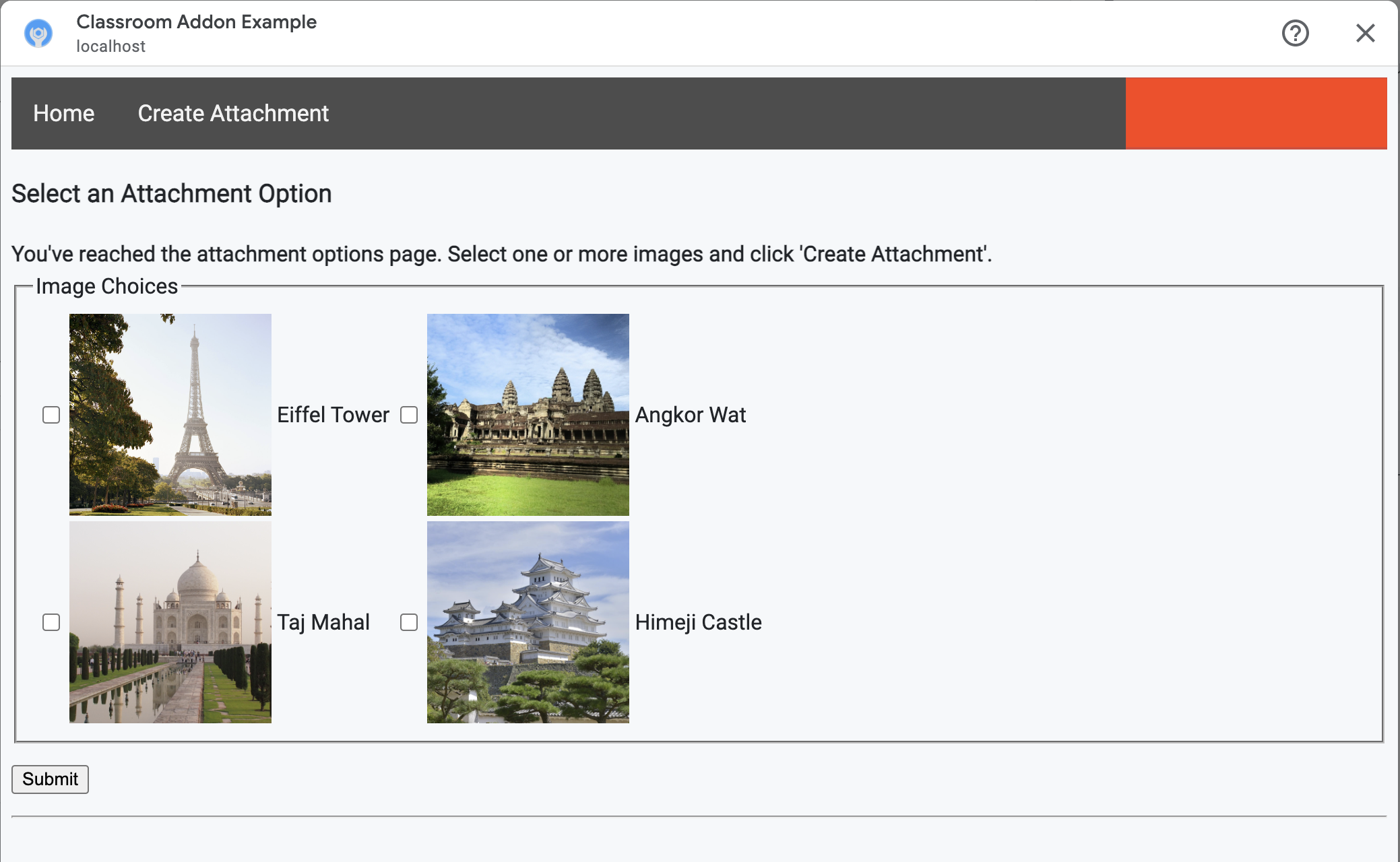這是 Classroom 外掛程式逐步操作說明系列的第四個逐步操作說明。
在本逐步導覽中,您將與 Google Classroom API 互動,建立附件。您提供路徑,供使用者查看附件內容。檢視畫面會依使用者在課程中的角色而有所不同。這份逐步操作說明涵蓋內容類型附件,這類附件不需要學生提交。
在本逐步操作說明中,您將完成下列事項:
- 擷取並使用下列外掛程式查詢參數:
addOnToken:傳遞至附件探索檢視畫面的授權權杖。itemId:接收外掛程式附件的 CourseWork、CourseWorkMaterial 或 Announcement 專屬 ID。itemType:可以是「courseWork」、「courseWorkMaterials」或「announcement」。courseId:Google Classroom 課程的專屬 ID,用於建立作業。attachmentId:Google Classroom 在建立外掛程式附件後指派的專屬 ID。
- 為內容類型附件實作永久儲存空間。
- 提供路徑來建立附件,以及提供老師檢視畫面和學生檢視畫面 iframe。
- 對 Google Classroom 外掛程式 API 發出下列要求:
- 建立新附件。
- 取得外掛程式環境,判斷登入的使用者是學生還是老師。
完成後,以老師身分登入時,即可透過 Google Classroom 使用者介面,在作業中建立內容類型附件。課程中的老師和學生也能查看內容。
啟用 Classroom API
從這個步驟開始呼叫 Classroom API。您必須先為 Google Cloud 專案啟用 API,才能呼叫該 API。前往 Google Classroom API 程式庫項目,然後選擇「啟用」。
處理附件探索檢視畫面查詢參數
如先前所述,Google Classroom 會在 iframe 中載入附件探索檢視畫面時傳遞查詢參數:
courseId:目前 Classroom 課程的 ID。itemId:接收外掛程式附件的 CourseWork、CourseWorkMaterial 或 Announcement 專屬 ID。itemType:可以是「courseWork」、「courseWorkMaterials」或「announcement」。addOnToken:用於授權特定 Classroom 外掛程式動作的權杖。login_hint:目前使用者的 Google ID。
本逐步操作說明將介紹 courseId、itemId、itemType 和 addOnToken。在對 Classroom API 發出呼叫時,請保留並傳遞這些值。
如上一個逐步解說步驟所述,請將傳遞的查詢參數值儲存在工作階段中。請務必在第一次開啟附件探索檢視畫面時執行這項操作,因為這是 Classroom 傳遞這些查詢參數的唯一機會。
Python
。前往提供附件探索檢視畫面路徑的 Flask 伺服器檔案 (如果您使用我們提供的範例,就是 attachment-discovery-routes.py)。在附加元件到達網頁路徑的頂端 (在我們提供的範例中為 /classroom-addon),擷取並儲存 courseId、itemId、itemType 和 addOnToken 查詢參數。
# Retrieve the itemId, courseId, and addOnToken query parameters.
if flask.request.args.get("itemId"):
flask.session["itemId"] = flask.request.args.get("itemId")
if flask.request.args.get("itemType"):
flask.session["itemType"] = flask.request.args.get("itemType")
if flask.request.args.get("courseId"):
flask.session["courseId"] = flask.request.args.get("courseId")
if flask.request.args.get("addOnToken"):
flask.session["addOnToken"] = flask.request.args.get("addOnToken")
只有在這些值存在時,才將其寫入工作階段;如果使用者稍後返回附件探索檢視畫面,但未關閉 iframe,系統就不會再次傳遞這些值。
為內容類型附件新增永久儲存空間
您需要建立任何附件的本機記錄。您可以使用 Classroom 提供的 ID,查詢老師選取的內容。
為 Attachment 設定資料庫結構定義。我們提供的範例會顯示圖片和說明文字的附件。Attachment 包含下列屬性:
attachment_id:附件的專屬 ID。由 Classroom 指派,並在建立附件時於回應中傳回。image_filename:要顯示的圖片本機檔案名稱。image_caption:要與圖片一起顯示的說明文字。
Python
從上一個步驟擴充 SQLite 和 flask_sqlalchemy 實作項目。
前往定義使用者資料表的檔案 (如果您是按照我們提供的範例操作,則為 models.py)。在檔案底部的 User 類別下方新增下列內容。
class Attachment(db.Model):
# The attachmentId is the unique identifier for the attachment.
attachment_id = db.Column(db.String(120), primary_key=True)
# The image filename to store.
image_filename = db.Column(db.String(120))
# The image caption to store.
image_caption = db.Column(db.String(120))
將新的 Attachment 類別匯入伺服器檔案,並使用附件處理路徑。
設定新路線
首先,請在本應用程式中設定一些新網頁,開始逐步導覽。 使用者可透過這些外掛程式建立及查看內容。
新增附件建立路徑
您需要網頁,供老師選取內容並發出建立附件的要求。實作 /attachment-options 路由,顯示內容選項供老師選取。此外,您還需要內容選取和建立確認頁面的範本。我們提供的範例包含這些範本,也可以顯示 Classroom API 的要求和回應。
請注意,您也可以修改現有的附件探索檢視畫面到達網頁,顯示內容選項,而不必建立新的 /attachment-options 頁面。建議您為本練習建立新網頁,保留第二個逐步解說步驟中導入的 SSO 行為,例如撤銷應用程式權限。這些範例在您建構及測試外掛程式時,應該會很有幫助。
老師可以從我們提供的範例中,選取一小組附有說明文字的圖片。我們提供了四張知名地標的圖片,說明文字是從檔案名稱衍生而來。
Python
在我們提供的範例中,這位於 webapp/attachment_routes.py 檔案中。
@app.route("/attachment-options", methods=["GET", "POST"])
def attachment_options():
"""
Render the attachment options page from the "attachment-options.html"
template.
This page displays a grid of images that the user can select using
checkboxes.
"""
# A list of the filenames in the static/images directory.
image_filenames = os.listdir(os.path.join(app.static_folder, "images"))
# The image_list_form_builder method creates a form that displays a grid
# of images, checkboxes, and captions with a Submit button. All images
# passed in image_filenames will be shown, and the captions will be the
# title-cased filenames.
# The form must be built dynamically due to limitations in WTForms. The
# image_list_form_builder method therefore also returns a list of
# attribute names in the form, which will be used by the HTML template
# to properly render the form.
form, var_names = image_list_form_builder(image_filenames)
# If the form was submitted, validate the input and create the attachments.
if form.validate_on_submit():
# Build a dictionary that maps image filenames to captions.
# There will be one dictionary entry per selected item in the form.
filename_caption_pairs = construct_filename_caption_dictionary_list(
form)
# Check that the user selected at least one image, then proceed to
# make requests to the Classroom API.
if len(filename_caption_pairs) > 0:
return create_attachments(filename_caption_pairs)
else:
return flask.render_template(
"create-attachment.html",
message="You didn't select any images.",
form=form,
var_names=var_names)
return flask.render_template(
"attachment-options.html",
message=("You've reached the attachment options page. "
"Select one or more images and click 'Create Attachment'."),
form=form,
var_names=var_names,
)
這會產生類似下方的「建立附件」頁面:

老師可以選取多張圖片。為老師在 create_attachments 方法中選取的每張圖片建立一個附件。
問題附件建立要求
現在您已知道老師想附加哪些內容,請向 Classroom API 發出要求,在作業中建立附件。收到 Classroom API 的回覆後,請將附件詳細資料儲存在資料庫中。
首先,取得 Classroom 服務的執行個體:
Python
在我們提供的範例中,這位於 webapp/attachment_routes.py 檔案中。
def create_attachments(filename_caption_pairs):
"""
Create attachments and show an acknowledgement page.
Args:
filename_caption_pairs: A dictionary that maps image filenames to
captions.
"""
# Get the Google Classroom service.
classroom_service = googleapiclient.discovery.build(
serviceName="classroom",
version="v1",
credentials=credentials)
向 courses.courseWork.addOnAttachments 端點發出 CREATE 要求。針對老師選取的每張圖片,請先建構 AddOnAttachment 物件:
Python
在我們提供的範例中,這是 create_attachments 方法的延續。
# Create a new attachment for each image that was selected.
attachment_count = 0
for key, value in filename_caption_pairs.items():
attachment_count += 1
# Create a dictionary with values for the AddOnAttachment object fields.
attachment = {
# Specifies the route for a teacher user.
"teacherViewUri": {
"uri":
flask.url_for(
"load_content_attachment", _scheme='https', _external=True),
},
# Specifies the route for a student user.
"studentViewUri": {
"uri":
flask.url_for(
"load_content_attachment", _scheme='https', _external=True)
},
# The title of the attachment.
"title": f"Attachment {attachment_count}",
}
每個附件至少須提供 teacherViewUri、studentViewUri 和 title 欄位。teacherViewUri 和 studentViewUri 代表附件由相應使用者類型開啟時載入的網址。
在要求主體中,將 AddOnAttachment 物件傳送至適當的 addOnAttachments 端點。每次提出要求時,請提供 courseId、itemId、itemType 和 addOnToken ID。
Python
在我們提供的範例中,這是 create_attachments 方法的延續。
# Use the itemType to determine which stream item type the teacher created
match flask.session["itemType"]:
case "announcements":
parent = classroom_service.courses().announcements()
case "courseWorkMaterials":
parent = classroom_service.courses().courseWorkMaterials()
case _:
parent = classroom_service.courses().courseWork()
# Issue a request to create the attachment.
resp = parent.addOnAttachments().create(
courseId=flask.session["courseId"],
itemId=flask.session["itemId"],
addOnToken=flask.session["addOnToken"],
body=attachment).execute()
在本地資料庫中為這個附件建立項目,以便稍後載入正確內容。Classroom 會在建立要求的回應中傳回不重複的 id 值,因此請將這個值做為資料庫中的主鍵。另請注意,Classroom 會在開啟老師和學生檢視畫面時傳遞 attachmentId 查詢參數:
Python
在我們提供的範例中,這是 create_attachments 方法的延續。
# Store the value by id.
new_attachment = Attachment(
# The new attachment's unique ID, returned in the CREATE response.
attachment_id=resp.get("id"),
image_filename=key,
image_caption=value)
db.session.add(new_attachment)
db.session.commit()
此時,請考慮將使用者導向確認頁面,確認他們已成功建立附件。
允許外掛程式提供附件
現在是將適當地址新增至 Google Workspace Marketplace SDK「應用程式設定」頁面中「允許的附件 URI 前置字元」欄位的好時機。外掛程式只能從這個頁面列出的其中一個 URI 前置字元建立附件。這項安全措施有助於降低攔截式攻擊的風險。
最簡單的方法是在這個欄位中提供頂層網域,例如 https://example.com。如果您使用本機電腦做為網路伺服器,則 https://localhost:<your port number>/ 適用。
新增老師和學生檢視畫面的路徑
Google Classroom 外掛程式可能會載入四個 iframe。 到目前為止,您只建構了用於提供附件探索檢視畫面 iframe 的路徑。接著,新增路徑來提供 Teacher 和 Student View iframe。
教師檢視畫面 iframe 可顯示學生體驗的預覽畫面,但也可以視需要納入額外資訊或編輯功能。
學生檢視畫面是學生開啟外掛程式附件時看到的頁面。
在本練習中,請建立單一/load-content-attachment
路徑,同時提供老師和學生檢視畫面。網頁載入時,請使用 Classroom API 方法判斷使用者是老師或學生。
Python
在我們提供的範例中,這位於 webapp/attachment_routes.py 檔案中。
@app.route("/load-content-attachment")
def load_content_attachment():
"""
Load the attachment for the user's role."""
# Since this is a landing page for the Teacher and Student View iframes, we
# need to preserve the incoming query parameters.
if flask.request.args.get("itemId"):
flask.session["itemId"] = flask.request.args.get("itemId")
if flask.request.args.get("itemType"):
flask.session["itemType"] = flask.request.args.get("itemType")
if flask.request.args.get("courseId"):
flask.session["courseId"] = flask.request.args.get("courseId")
if flask.request.args.get("attachmentId"):
flask.session["attachmentId"] = flask.request.args.get("attachmentId")
請注意,您也應在這個階段驗證使用者身分。您也應該在此處理 login_hint 查詢參數,並視需要將使用者導向授權流程。如要進一步瞭解這個流程,請參閱先前逐步解說中討論的登入指南詳細資料。
然後向與項目類型相符的 getAddOnContext 端點傳送要求。
Python
在我們提供的範例中,這是 load_content_attachment 方法的延續。
# Create an instance of the Classroom service.
classroom_service = googleapiclient.discovery.build(
serviceName="classroom"
version="v1",
credentials=credentials)
# Use the itemType to determine which stream item type the teacher created
match flask.session["itemType"]:
case "announcements":
parent = classroom_service.courses().announcements()
case "courseWorkMaterials":
parent = classroom_service.courses().courseWorkMaterials()
case _:
parent = classroom_service.courses().courseWork()
addon_context_response = parent.getAddOnContext(
courseId=flask.session["courseId"],
itemId=flask.session["itemId"]).execute()
這個方法會傳回目前使用者在課程中的角色資訊。根據使用者的角色,變更向使用者顯示的檢視畫面。回應物件中會填入 studentContext 或 teacherContext 欄位。請檢查這些資訊,判斷如何稱呼使用者。
無論如何,請使用 attachmentId 查詢參數值,瞭解要從資料庫中擷取哪個附件。開啟老師或學生檢視畫面 URI 時,系統會提供這個查詢參數。
Python
在我們提供的範例中,這是 load_content_attachment 方法的延續。
# Determine which view we are in by testing the returned context type.
user_context = "student" if addon_context_response.get(
"studentContext") else "teacher"
# Look up the attachment in the database.
attachment = Attachment.query.get(flask.session["attachmentId"])
# Set the text for the next page depending on the user's role.
message_str = f"I see that you're a {user_context}! "
message_str += (
f"I've loaded the attachment with ID {attachment.attachment_id}. "
if user_context == "teacher" else
"Please enjoy this image of a famous landmark!")
# Show the content with the customized message text.
return flask.render_template(
"show-content-attachment.html",
message=message_str,
image_filename=attachment.image_filename,
image_caption=attachment.image_caption,
responses=response_strings)
測試外掛程式
請按照下列步驟測試附件建立作業:
- 以其中一位老師測試使用者身分登入 [Google Classroom]。
- 前往「課堂作業」分頁,然後建立新的「作業」。
- 按一下文字區域下方的「外掛程式」按鈕,然後選取所需外掛程式。 系統會開啟 iframe,外掛程式會載入您在 Google Workspace Marketplace SDK 的「應用程式設定」頁面中指定的「附件設定 URI」。
- 選擇要附加到作業的內容。
- 附件建立流程完成後,請關閉 iframe。
Google Classroom 的作業建立 UI 中應該會顯示附件卡片。按一下資訊卡開啟「老師檢視畫面」iframe,確認顯示的附件正確無誤。按一下「指派」按鈕。
如要測試學生的體驗,請完成下列步驟:
- 然後以學生測試使用者的身分登入 Classroom,加入與老師測試使用者相同的課程。
- 在「課堂作業」分頁中找出測驗作業。
- 展開作業,然後按一下附件資訊卡,開啟「學生檢視畫面」 iframe。
確認學生看到正確的附件。
恭喜!現在可以繼續下一個步驟:建立活動類型附件。
